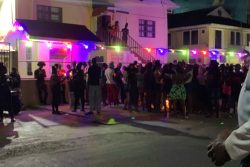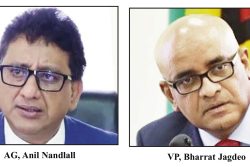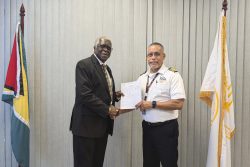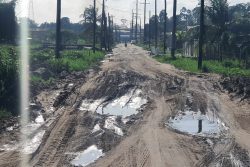Dear Editor
The performance of the Guyana Police Force (GPF) is under constant scrutiny. The vexed question is how does one conduct a performance appraisal on a police force that is short of over one thousand ranks ‒ and that is in accordance with the 1976 authorised strength ‒ a police force that needs many more boots of various sizes and quality on the ground, since boots on the ground are the first step to preventing crime; a law enforcement agency which encounters witnesses who are reluctant to attend identification parades and are fearful of testifying in court; a police force that has serious communication issues and concerns at the apex of management; a police force that has instructors who do not understand and appreciate the basic concept of andragogy and have a phobia for an eclectic approach towards training; and a police force that lacks the resources to conduct rapid response operations in relation to reports of serious crimes at certain locations.
Despite all these challenges and many more, some sections of the Force, particularly the Major Crimes Unit, have sparkled. That unit has brought numerous hard core criminals to justice including many who were involved in cold cases spanning several years. It has dismantled numerous armed gangs, but more are emerging. In addition, Assistant Commissioner Ian Amsterdam, Senior Superintendent Stephen Mansell and Assistant Commissioner Clifton Hicken have done some great work in their community-oriented policing and problem solving (COPPS) approach towards the reduction of crime. Their efforts have been very fruitful. Not surprisingly, since Stephen Mansell proceeded on extended vacation leave during September, 2016 and is still on leave, very little or nothing has been heard of community intervention in the division he commanded. If there are police/communities activities they are not made public. There is thick wall of silence. Serious crime is on the increase in that division.
In measuring the efficiency and effectiveness of a department like the Guyana Police Force, many people including the police tend to use crime rates, number of arrests, cases made including traffic matters and clear-up rates to measure how the police are doing. Karen Hess and Christine Orthmann (2012) opine that clearance rates are notoriously unreliable and arrest data are suspect. They explain that ghosting may occur ‒ the falsifying of patrol logs to make the numbers come out right. I read in the media that persons are questioning the accuracy of crime stats produced by the police. There has been a state of denial. One senior official angrily mentioned that the police do not manufacture stats and that the input is done electronically. Whether or not the stats are done electronically or manually, the possibility of ghosting exists. In my policing career I heard senior officers directing ranks to “cook the stats so that we can look good.” Michael Holding used to say, “Garbage in garbage out” – GIGO. I do not know what is presently operating in the GPF, but the possibility of ghosting cannot be overlooked. It was done before in a large division while Henry Greene was the commissioner of police. History can repeat itself, if it has not already done so.
Wayne Bennett and Karen Hess (2004) suggest that low crime rates do not necessarily mean a police agency is efficient and effective. A high arrest rate does not necessarily show that the police are doing a good job. A high ratio of police officers to citizens does not necessarily mean high-quality police service. Responding quickly to calls for service does not necessarily indicate that the police agency is efficient.
Kramer and Fielder (2002) summarise the problem succinctly: “Traditional measurements, such as the uniform crime reports…arrest and tickets tabulate only events. They do not measure whether the activities were completed effectively and efficiently, and that they don’t describe what impact the activities had on the community.” They suggest that rather than looking at crime rates, number of arrests and respond times, evaluation should assess whether the agency is effective in fulfilling its responsibilities to the community. Evaluation must also consider the entire agency and how well it is accomplishing its mission.
The mission statement of the Guyana Police Force reads, “The mission of the Guyana Police Force and its auxillaries is to serve all the citizens of Guyana in a professional, proactive and accountable manner. To achieve this, we will work in partnership with communities, public agencies and private bodies to enhance and support an environment where all people are preventing crime and building a safer and secure Guyana.” This mission statement was designed and implemented by the disbanded Police Strategic Management Unit.
The framers of this mission statement were a bit careless, and their statement reckless and dangerous, but not fatal. How can we have a situation whereby “all people are preventing crime and building a safer and secure Guyana?” It is not realistic. It is not achievable. Where will the police be if all are involved in preventing crime and building a safer Guyana?
Most citizens want to live in safe, orderly neighbourhoods. The police are considered effective when they produce the perception that crime is under control. Reduction of fear is a very important measure.
Citizens’ approval or disapproval is generally reflected in letters to the editor, letters of criticism or commendation, cooperation over incidents being investigated, support for proposed police programmes, public reaction to a police-citizen incident or responses to police-initiated surveys.
Wayne Bennett and Karen Hess (2004) posit that one way to assess citizen approval or disapproval is through citizens’ surveys which can measure the trends and provide positive and negative feedback on the public’s impression of law enforcement.
They explained that community surveys are often win-win situations. Citizens are better served and officers receive positive feedback. Community surveys can also be key in establishing communication.
Yours faithfully,
Clinton Conway
Assistant Commissioner of Police
(Ret’d)








